
PYRITE
Specimen pyr-25
$ 95.00
Dims: 6.2" x 2.5" x 2.5" (15.7 x 6.4 x 6.4 cm)
Wt: 2 lbs., 9.9 oz. (1.189 kg)
Uruchacua Mine, Ancash, Peru
This specimen consists of scores of cubic Pyrite crystals that have intergrown to form a crust. These crystals range from 3 mm to about 1.0" (2.5 cm) along an edge. They are in very good condition, generally, with a small amount of damage, and clean edges and faces that have noticeable uniform, parallel striations running across them. They have the standard pale golden color and metallic luster of Pyrite, and occur in a section of crust that contains small hollow pockets that are lined with more crystals. The underside of the section also has many visible crystals, though most of them are damaged and incomplete. Besides the Pyrite, there are many tiny, barrel-shaped calcite crystals nestled among the cubes on the specimen's underside, and several large and impressive siderite crystals among the larger cubes on the top of the section. The calcites are white colored, the siderites are pale brown, and both are translucent and have a pearly luster. Though I have looked at this specimen many times before, I never noticed those siderite crystals until I just examined it to write this description.

 Amethyst Galleries' Mineral Gallery MINERALS |

PYRITE specimen pyr-4
$ 96.00
$ 96.00
Dims: 4.75" x 4.25" x 1.50"
Wt: 2.25lb
unknown
This is our "Mystery Piece." I've got the location of this specimen narrowed to two localities: either Missouri or Peru. I personally think it's Missouri. Also, we're not sure if the specimen was initially Pyrite when it formed, or if it started out as a botryoidal form of Marcasite and then pseudomorphed. I think that it started out as Marcasite, personally, which would support my Missouri location theory. Either way, it's an odd formation that is almost amusing, making me conjure up the idea of a pyritized "Coprolite," or "fossil poop."

pyr-4 ($ 96.00)
unknown

PYRITE specimen pyr-7
$ 18.00
$ 18.00
Dims: 2-1/4" x 1-1/4" x 1"
Wt: 4.1 oz
to be announced
The reason that we have such a small, unimpressive-looking specimen for sale is because it's background redeems it. This Pyrite nodule envelops a Pyritized fossil clam shell! In some areas, like parts of Germany, Russia, and northwestern Ohio in the United States, fossils become coated with or replaced by Pyrite during the preservation process. This is one of those instances! Do you have one of these in your collection?

pyr-7 ($ 18.00)
to be announced

PYRITE specimen pyr-8
$ 150.00
$ 150.00
Dims: 6" x 5-1/4" x 3-1/2"
Wt: 4 lbs., 12 oz
Ancash, Peru
This is one of the largest pieces of Pyrite that we have in our selection. It is composed of incomplete cubic crystals that max out at 2-1/8 x 2 inches in size. They have clean, clear faces with striations running parallel to the edges and some pitting that looks as if it was caused by early Calcite crystal formation. There is a rather large, alarming-looking crack running across the piece, slightly separating a third or so of the piece from the rest of it. As Calcite crystals have formed inside the crack, one can deduce that the crack was there before the piece was excavated. This is a mongo piece, approaching museum-quality.

pyr-8 ($150.00)
Ancash, Peru

PYRITE specimen pyr-15
$ 45.00
$ 45.00
Dims: 3.0" x 1.2" x 1.8"(7.6 x 3.0 x 4.6 cm)
Wt: 4.50 oz.(127.8 g.)
Carson Hill Mine, Calaveras County, California, U.S.A.
This specimen reminds me very much of the cubic Pyrite crystals that come out of Spain, with its whitish, finely-grained matrix rock. However, the similarity ends with more than a casual glance. The limestone matrix is not nearly as finely-grained, and the crystals have a pyritohedral shape instead of a cubic one. There are two crystals visible; the larger one has visible dimensions of 1.1 x 0.6"(2.8 x 1.5 cm) and the smaller has those of 0.3 x 0.4"(8 x 10 mm). They are undamaged by human forces, and what could be construded as damage is confined to one edge and one corner of the larger crystal. Needless to say, they have the pale yellow coloration, metallic luster, and striated faces that are common in Pyrite. I have not seen such a pleasant setting before. These are definitely natural in origin and have not been placed in or broken and glued in. One could have a little bit of fun exposing both crystals a bit more- I personally love such projects.
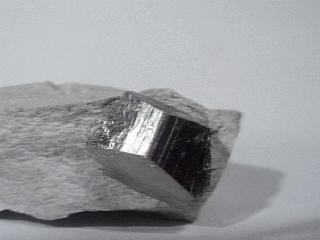

pyr-15 ($ 45.00)
Carson Hill Mine, Calaveras County, California, U.S.A.

PYRITE specimen pyr-18
$ 60.00
$ 60.00
Dims: 3.5" x 2.5" x 1.4"(8.9 x 6.4 x 3.6 cm)
Wt: 4.90 oz.(138.8 g)
level 4, Los Remedios Mine, Taxco, Guerrero, Mexico
This beautiful specimen consists of several white dogtooth calcite crystals grown around a cluster of Pyrite crystals that, likely due to different impurities, has taken on a variety of colors and forms. Most of the material has a green tint to it, but this fades to a deep golden color in one area and some stray groups and crystals around the main cluster have a red color that makes me think of copper. Actually, a few of the small crystals may be copper, given their excellent octahedral and cubo-octahedral forms. It looks as if all of these crystals have this form to a degree. The crystals have the standard metallic luster and opacity of Pyrite, though they could conceivably be more chalcopyrite given their color range. They are quite small, as no single crystal exceeds 3 mm along an edge. The white calcites are in the scalenohedral "dogtooth" form, and though crystal faces are difficult to determine, they all have exceptional form and are surprisingly undamaged. Some of these crystals are arranged as end-to-end twins They are translucent and have an almost silky luster. They rest with the Pyrites on a bed of white, translucent quartz crystals that coat a base rock made of chert, or possibly a finely-grained quartzite. I am amazed at the excellence of the crystals' forms on this specimen.
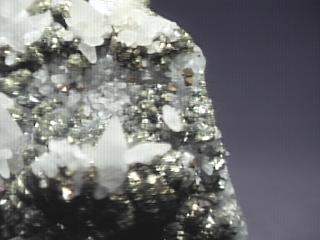

pyr-18 ($ 60.00)
level 4, Los Remedios Mine, Taxco, Guerrero, Mexico

PYRITE specimen pyr-21
$ 23.00
$ 23.00
Dims: 1.9" x 1.8" x 1.3"(4.8 x 4.6 x 3.3 cm)
Wt: 3.36 oz.(95.5 g)
Inuvik, Northwest Territories, Canada
If I didn't know any better, I would swear that this Pyrite specimen was actually composed of marcasite. I have been told by a knowledgeable source, however, that it is actually Pyrite. The piece consists of many intergrown cubes that generally measure about 0.2 - 0.3" (5 - 8 mm) along an edge. Their form is reasonably good, showing curved faces and edges (which made me think "marcasite"); there are a few spots of substantial damage, but the specimen still is in pretty good condition. The crystals have the obligatory pale gold color and metallic luster of Pyrite, and make up the specimen in its entirety- there is no host rock or other foreign material.

pyr-21 ($ 23.00)
Inuvik, Northwest Territories, Canada

PYRITE specimen pyr-23
$ 24.00
$ 24.00
Dims: 2.7" x 1.8" x 1.2" (6.9 x 4.6 x 3.0 cm)
Wt: 3.78 oz. (107.3 g)
El Navajun, La Rioja, Spain
This simple piece is what I expect from the Spanish locality where it occurred. It consists of a chalky, cream-colored host rock in which rest two intergrown Pyrite cubes. The smaller one has dimensions of 0.3 x 0.3 x 0.2" (0.8 x 0.8 x 0.5 cm), and the larger one measures 0.5 x 0.5 x 0.4" (1.3 x 1.2 x 1.0 cm). Both of these cubes are in excellent condition, with clean faces and edges and only a very small amount of damage. They are mostly exposed; only a small amount of their surface areas are actually enclosed in the matrix rock. I have met many people who assumed that these cubes were cut and polished into their cubic shapes and then partially anchored into some type of concrete, but the subtle striations on their faces would be too difficult to reproduce.


pyr-23 ($ 24.00)
El Navajun, La Rioja, Spain

PYRITE specimen pyr-25
$ 95.00
$ 95.00
Dims: 6.2" x 2.5" x 2.5" (15.7 x 6.4 x 6.4 cm)
Wt: 2 lbs., 9.9 oz. (1.189 kg)
Uruchacua Mine, Ancash, Peru
This specimen consists of scores of cubic Pyrite crystals that have intergrown to form a crust. These crystals range from 3 mm to about 1.0" (2.5 cm) along an edge. They are in very good condition, generally, with a small amount of damage, and clean edges and faces that have noticeable uniform, parallel striations running across them. They have the standard pale golden color and metallic luster of Pyrite, and occur in a section of crust that contains small hollow pockets that are lined with more crystals. The underside of the section also has many visible crystals, though most of them are damaged and incomplete. Besides the Pyrite, there are many tiny, barrel-shaped calcite crystals nestled among the cubes on the specimen's underside, and several large and impressive siderite crystals among the larger cubes on the top of the section. The calcites are white colored, the siderites are pale brown, and both are translucent and have a pearly luster. Though I have looked at this specimen many times before, I never noticed those siderite crystals until I just examined it to write this description.


pyr-25 ($ 95.00)
Uruchacua Mine, Ancash, Peru

PYRITE specimen pyr-27
$ 21.00
$ 21.00
Dims: 4.0" x 3.9" x 0.2" (10.2 x 9.9 x 0.5 cm)
Wt: 4.43 oz. (125.7 g)
Sparta, Illinois, U.S.A.
This lovely specimen is what one expects from its locality- it is a Pyrite "dollar", or "sun", a usually round, flat concretion that is found in layers of shale between coal seams. Sparta, in the northern U.S. state of Illinois, is the only locality where these concretions are found in any abundance- most of the world's supply consists of what coal miners can carry to the surface. This particular specimen is not shaped like a complete circle. Each face of the "sun" has striations that radiate 360-degrees from a central point where the sun first started to form. It has the pale golden color and metallic luster of Pyrite and is in excellent condition, showing no human-induced damage. I consider the Pyrite sun to be an essential part of any serious collection.

pyr-27 ($ 21.00)
Sparta, Illinois, U.S.A.

PYRITE specimen pyr-28
$ 25.00
$ 25.00
Dims: 4.3" x 3.7" x 0.4" (10.9 x 9.4 x 1.0 cm)
Wt: 8.95 oz. (254.0 g)
Sparta, Illinois, U.S.A.
This Pyrite specimen is in the form of a "sun" or "dollar", a flat, round concretion that is found in veins of shale in coal mines. It forms a slightly elongated but nearly complete circle and is in excellent condition, with no visible human-induced damage. Each face of the sun has striations that radiate out from a central point in a 360-degree arc. The dollar has a pale golden color and a bright metallic luster on one side, whereas the other side is much duller. It is a very beautiful specimen, and is thicker than most suns with regard to its diameter. Often this thickness is correlated to a very regular circular shape.


pyr-28 ($ 25.00)
Sparta, Illinois, U.S.A.

PYRITE specimen pyr-29
$ 25.00
$ 25.00
Dims: 4.0" x 4.0" x 0.4" (10.2 x 10.2 x 1.0 cm)
Wt: 8.09 oz. (229.5 g)
Sparta, Illinois, U.S.A.
This particular Pyrite sun has the most regular shape that I have seen in a long time. Though not perfectly round, it is pretty close, with rather smooth edges with regard to its shape. Its faces are heavily striated with lines that radiated in a 360-degree arc from a central point, and it has the pale yellow coloration and metallic luster of Pyrite. It is unusually thick for a sun of its diameter. This specimen would make a great addition to a home as either a mineral specimen or a decoration, or both!

pyr-29 ($ 25.00)
Sparta, Illinois, U.S.A.
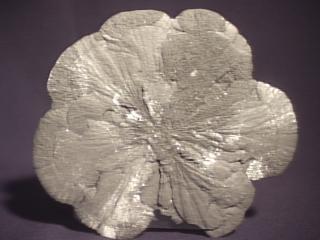
PYRITE specimen pyr-30
$ 27.00
$ 27.00
Dims: 5.5" x 4.7" x 0.2" (14.0 x 11.9 x 0.5 cm)
Wt: 9.46 oz. (268.4 g)
Sparta, Illinois, U.S.A.
This particular Pyrite concretion or "sun" experienced growth either on an uneven surface, or it experienced some significant environmental changes during its formation. Thus, its shape is not really round- I prefer to call such specimens "Mickey Mouse" suns, as their outline sometimes resembles Mickey Mouse's silhouette. It has many striations that radiate in 360-degree arcs from single points on each of its faces and seems to show some visible layering. It has the standard pale gold coloration and metallic luster of Pyrite. There may be one small spot of breakage on the edge of the specimen, but it is not very noticeable; it is difficult to determine whether this was human-induced or not.

pyr-30 ($ 27.00)
Sparta, Illinois, U.S.A.

PYRITE specimen pyr-31
$ 30.00
$ 30.00
Dims: 6.7" x 5.1" x 0.3" (17.0 x 13.0 x 0.8 cm)
Wt: 1 lb., 2.9 oz. (536 g)
Sparta, Illinois, U.S.A.
One of the larger, heavier Pyrite suns that I have seen, this specimen likely grew on an uneven surface. Its shape constitutes a little more than half of a circle, with rather irregular, uneven edge on the incomplete side. However, it is undamaged, by either humans or nature, and its "circular" edge is smooth and regular. Its faces are covered with a thin layer of Pyrite that consists of countless tiny crystals, dulling its metallic luster and obscuring the radiating striations that are usually visible. Its color is the standard pale gold of Pyrite. Though not as shiny as many suns that I have seen, this specimen is very large and rather unusual.

pyr-31 ($ 30.00)
Sparta, Illinois, U.S.A.

PYRITE specimen pyr-32
$ 35.00
$ 35.00
Dims: 5.7" x 4.9" x 0.5" (14.5 x 12.4 x 1.3 cm)
Wt: 15.8 oz. (447 g)
Sparta, Illinois, U.S.A.
This large Pyrite sun has a rather irregular shape that is closer to that of a rounded rectangle than a circle. It shows a patch of visible damage along one edge where a circular projection broke off, but as the projection broke off cleanly and almost completely, the breakage does not spoil the sun's shape. It shows obvious layering from changes in its formation, and has the heavy striations that radiate from a central point on each face. Its color is its most impressive aspect; this piece has a much deeper, more bronze-golden color than Pyrite usually has, and shows glimpses of orange and reddish iridescence. I have seen hundreds of Pyrite suns, and very few of them had this coloration at this size.


pyr-32 ($ 35.00)
Sparta, Illinois, U.S.A.
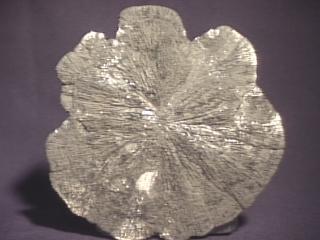
PYRITE specimen pyr-33
$ 35.00
$ 35.00
Dims: 5.5" x 5.5" x 0.2" (14.0 x 14.0 x 0.5 cm)
Wt: 10.14 oz. (287.7 g)
Sparta, Illinois, U.S.A.
I am surprised that this Pyrite sun has not been broken. It is one of the largest that I have seen for its thickness, and shows no damage. It has what I call the "Mickey Mouse" shape, wherein its round shape is interrupted by smaller, round protrusions. As with most other Pyrite suns, each face is striated with lines that radiate outward along a 360-degree arc from a central point. Its color is pale gold and it has a metallic luster that varies in brilliance according to the texture of the sun's surface.

pyr-33 ($ 35.00)
Sparta, Illinois, U.S.A.

PYRITE specimen pyr-34
$ 65.00
$ 65.00
Dims: 11.0" x 9.2" x 1.0" (27.9 x 23.4 x 2.8 cm)
Wt: 3 lbs., 6.5 oz. (1.544 kg)
Sparta, Illinois, U.S.A.
This Pyrite sun specimen is still partially embedded in its shale matrix. The sun itself is not quite round in shape, measuring 4.0 x 3.4" (10.2 x 8.6 cm), and is rather thin, measuring 0.2" (0.5 cm) as far as I can tell. It shows a small amount of layering, and the one visible face is striated with lines that radiate out in a 360-degree arc from a central point. It has a rather deep golden color and shows hints of red and orange iridescence. It also has a slightly dull metallic luster. The black shale host rock on which it rests has been coated with a lacquer for protection and cosmetic purposes. It is a really neat speciemen that convinces the viewer that Pyrite suns are not fabricated by humans (this misconception is not uncommon).


pyr-34 ($ 65.00)
Sparta, Illinois, U.S.A.

PYRITE specimen pyr-36
$ 36.00
$ 36.00
Dims: 5.8" x 3.9" x 0.6" (14.7 x 9.9 x 1.5 cm)
Wt: 8.06 oz. (228.5 g)
Sparta, Illinois, U.S.A.
Though the black shale host rock on which this "Pyrite Sun" grew is repaired, it gives one a pretty good idea of just how these concretions are found. The Pyrite sun is nearly perfectly round and measures 0.8" (2.0 cm) in diameter and 0.1" (0.3 cm) thick. It rests in a depression that appears to have been widened by human work. A crack runs completely through the shale, and appears to have been broken and repaired. It is, however, a beautiful little specimen that would look quite attractive on a mantle or a shelf.


pyr-36 ($ 36.00)
Sparta, Illinois, U.S.A.

$ 350.00
Dims: 8.3" x 7.9" x 3.8" (21.1 x 20.1 x 9.7 cm)
Wt: 13.3 lbs. (6.1 kg)
Pachapaque Mine, Ancash, Peru
One of the larges Pyrite specimens in our stock, this piece consists of dozens of intergrown crystals that range from 0.5+ - 2.0" (1.3+ -5.1 cm) in diameter. There is moderate damage to the piece besides the break due to its separation from its place of origin. Though the crystals are well-formed, they have a shape that is unfamiliar to me. It could be a tetrahexahedral form, or a variation of the diploid; their intergrowth doesn't leave enough of any crystal exposed for me to give a more accurate description. Attached to the cluster is a piece of an extremely large crystal- there is only one triangular face that is nearly complete, and it measures 3" (7.6 cm) along an edge. The crystals have well-developed edges and clean, smooth faces that show off their pale gold color and shiny metallic luster. There is no other material attached to the piece, nor is there any host rock. It sparkles quite brilliantly in bright light, and would make a good addition to a serious collection.


Pachapaque Mine, Ancash, Peru

PYRITE specimen pyr-39
$ 40.00
$ 40.00
Dims: 2.2" x 2.0" x 1.5" (5.6 x 5.1 x 3.8 cm)
Wt: 8.09 oz. (229.3 g)
Pachapaque Mine, Ancash, Peru
A lovely little hand specimen, this piece consists of part of a large cluster of Pyrite crystals. It consists of at least a dozen intergrown pyritohedrons, the largest of which is nearly complete and measures about 1.3" (3.3 cm) in diameter. The specimen is in generally good condition, showing moderate damage besides that on the area where the specimen was separated from its place of origin. All the crystals show well-defined edges and slightly striated faces that show off the Pyrite's pale gold color and metallic luster. It has some of the most well-formed Pyrite crystals of our present stock.

pyr-39 ($ 40.00)
Pachapaque Mine, Ancash, Peru

PYRITE specimen pyr-40
$ 45.00
$ 45.00
Dims: 2.9" x 2.2" x 1.5" (7.4 x 5.6 x 3.8 cm)
Wt: 10.63 oz. (301.3 g)
Cananaea, Sonora, Mexico
This specimen consists of a cluster of scores of intergrown cubic Pyrite crystals. They are in generally good condition, though many crystals show visible damage or substantial breakage. Cubes range in size from a few millimeters to 0.4" (1.0 cm) along an edge. Their form is excellent, with very clean, smooth faces and sharp edges where intact. They have the standard pale gold color and metallic luster of this mineral. Upon first glance, the cluster appears to be entirely pure, but examination under magnification shows that many tiny patches of brown calcite and black sphalerite crystals are scattered about. There is even a small patch of actinolite needles visible that are ringed by some calcites. I have not seen many Pyrite specimens from Mexico that have crystals as good in quality as these.

pyr-40 ($ 45.00)
Cananaea, Sonora, Mexico

PYRITE specimen pyr-41
$ 105.00
$ 105.00
Dims: 4.7" x 3.1" x 3.1" (11.9 x 7.9 x 7.9 cm)
Wt: 2 lbs., 6.8 oz. (1.101 kg)
Cananaea, Sonora, Mexico
These are the largest Pyrite crystals that I have seen from a Mexican locality. This specimen consists of a cluster of Pyrite cubes that reach dimensions up to 2.7 x 1.7 x 1.5" (6.9 x 4.3 x 3.8 cm). The cluster is in generally good condition, though the larger crystals tend to show substantial damage or are not quite complete. They have excellent cubic form, though, with clean faces and sharp edges. The crystals have the standard pale-gold color and metallic luster of Pyrite, and are accompanied by a substantial amount of what appears to be heavily-weathered galena. The galena does not show any noticeable damage and occurs as rounded gray blobs that measure less than 3 mm in diameter and have a matte luster. There are also patches of weathered, rusty calcite and fibrous actinolite needles.

pyr-41 ($105.00)
Cananaea, Sonora, Mexico

PYRITE specimen pyr-42
$ 105.00
$ 105.00
Dims: 6.2" x 5.8" x 4.0" (15.7 x 14.7 x 10.2 cm)
Wt: 10.3 lbs. (4.7 kg)
Pachapaque Mine, Ancash, Peru
This rather massive Pyrite specimen consists of dozens of intergrown pyritohedral crystals that range from 0.5 - 2.5" (1.3 - 6.4 cm) in diameter. The specimen is generally in very good condition, though there are two very large breakage surfaces where the specimen was separated from its host rock. All of the crystals have clean, striated faces and well-defined edges that show only a small amount of wear in places. The crystals are very heavily intergrown, so that not more than 2 faces on any given crystal are complete. They have the standard pale gold color and metallic luster of Pyrite. The piece has experienced a small but noticeable amount of crumbling since we have had it, so it may be prudent to avoid handling it.

pyr-42 ($105.00)
Pachapaque Mine, Ancash, Peru

PYRITE specimen pyr-45
$ 30.00
$ 30.00
Dims: 4.7" x 4.0" x 0.6" (11.9 x 10.2 x 1.5 cm)
Wt: 8.61 oz. (244.1 g)
Sparta, Illinois, U.S.A.
A rather small example of the well-known product of the coal mines of Sparta, Illinois, this specimen consists of a slab of black shale host rock that holds a single Pyrite "sun" or "dollar", a round, flat concretion. This particular sun is rather small, having a diameter of 1.3" (3.3 cm) and a thickness of 0.1 (0.3 cm), but is in excellent condition, showing no damage. It has a rather pale golden coloration and an almost matte, metallic luster. It does not appear to have been broken out of the rock and re-attached, though many often are. The shale host rock has a rather smooth texture and a slightly waxy sheen to it- I believe that it has been impregnated with a sealant to give it more strength and darken it for better contrast.


pyr-45 ($ 30.00)
Sparta, Illinois, U.S.A.

PYRITE specimen pyr-46
$ 85.00
$ 85.00
Dims: 3.5" x 3.0" x 2.4" (8.9 x 7.6 x 6.1 cm)
Wt: 9.57 oz. (271.4 g)
Logrono, Spain
This hand specimen consists of a chunk of chalky brown host rock that holds 3 visible cubic Pyrite crystals. They are in excellent condition, showing no human-induced damage. The largest of the 3 measures 0.7" (1.8 cm) along an edge, and the others are considerably smaller. All have excellent, nearly perfect cubic form and have well-defined edges and slightly striated but regular faces that show a bright, metallic luster. They have the standard pale gold coloration that is common for Pyrite. The two larger crytstals may have broken out of their places and were cemented back in, but the smaller crystal certainly has not.

pyr-46 ($ 85.00)
Logrono, Spain

$1500.00
Dims: 11.0" x 9.5" x 5.0" (29.2 x 24.1 x 12.7 cm)
Wt: 31.8 lbs. (14.5 kg)
Huanzala Mine, Ancash, Peru
This very large cabinet specimen consists of a cluster that is made up of at least 10 different Pyrite octahedrons. Only one of these octahedral crystals could be called complete, and only about half of it is showing, as the rest of it is intergrown with the cluster. However, it is huge, having visible dimensions of 4.5 x 3.8 x 3.6" (11.4 x 9.7 x 9.1 cm)! Most of the others are either mostly intergrown or are incomplete due to the separation of the specimen from its place of origin. All show excellent octahedral form, though, with clean, straight edges and relatively smooth, flat faces. Most of these faces are dusted with smatterings of small, rounded sphalerite crystals; some Pyrite faces are much more heavily dusted than others. The Pyrite has the classic pale-gold color and bright, metallic luster that one expects. Other than the sphalerites, there is no host rock or other associated materials. Though mostly rounded, many of the hundreds of sphalerite crystals show some semblance of crystal form. They appear to be nearly black in color, and their luster ranges from waxy to submetallic.


Huanzala Mine, Ancash, Peru

PYRITE specimen pyr-48
$ 130.00
$ 130.00
Dims: 2.7 x 2.6 x 1.6" (6.9 x 6.6 x 4.1 cm)
Wt: 6.9 oz. (195.7 g)
Huaron Mine, Ancash, Peru
This small hand specimen consists of a cluster of intergrown Pyrite crystals that rest on a semicrystalline sphalerite base. These crystals are in generally good conditon, though several are noticeably damaged or broken. The largest of these crystals has visible dimensions of 0.6 x 0.5 x 0.5" (1.5 x 1.3 x 1.3 cm), and like all of the others, is heavily intergrown with at least one other crystal. Their form appears to be cubic upon first glance, but close examination shows that most of the edges and faces are not straight. I suppose that growing conditions may account for these lapses in symmetry, as both large and small crystals show this oddity. Otherwise, they appear to be perfectly normal, with the pale golden color and bright metallic luster that is standard for Pyrite. There are a few sprays of tiny quartz crystals arranged on or about the cluster, and the sphalerite base has the standard dark brown color, though its luster is quite dull, probably due to weathering or water-wear.


pyr-48 ($130.00)
Huaron Mine, Ancash, Peru

PYRITE specimen pyr-49
$ 25.00
$ 25.00
Dims: 0.8 x0.8 x 0.6" (2.0 x 2.0 x 1.5 cm)
Wt: 22.0 g w/ base
Inuvik, Northwest Territories, Canada
This interesting thumbnail specimen consists of a cluster of Pyrite pseudomorphs. All are in excellent condition and do not exceed 0.5" (1.3 cm) in length. They have the form of thick orthorhombic blades and are well-preserved in that shape. Their pale golden color and metallic luster is standard for their species, and a cluster of tiny marcasite blades appears to serve as a base. The piece is hot-glued to a flat, square acrylic base.

pyr-49 ($ 25.00)
Inuvik, Northwest Territories, Canada

PYRITE specimen pyr-50
$ 30.00
$ 30.00
Dims: 4.5 x 3.2 x 1.5" (11.4 x 8.1 x 3.8 cm)
Wt: 11.8 oz. (334 g)
Duff Quarry, Huntsville, Logan County, Ohio, U.S.A.
Scores of very small Pyrites line 2 cavities in the shale host rock of this hand specimen. These crystals are generally in excellent condition and do not exceed 0.2" (5 mm) in diameter. Though they are rather heavily intergrown, their form is excellent and slightly unusual- every one of them is a 24-sided trapezohedron! All have an almost coppery-red color and a moderate metallic luster. They are accompanied by several small clusters of white dolomite.

pyr-50 ($ 30.00)
Duff Quarry, Huntsville, Logan County, Ohio, U.S.A.

PYRITE specimen pyr-51
$ 28.00
$ 28.00
Dims: 3.7 x 2.6 x 1.5" (9.4 x 6.6 x 3.8 cm)
Wt: 12.0 oz. (339 g)
Pachapaque Mine, Ancash Department, Peru
Several Pyrite crystals rest on the sphalerite base of this hand specimen. The Pyrites are generally in good condition and reach lengths of nearly 0.6" (1.5 cm). All have a somewhat warped cubic form that appears to be taking on pyritohedral tendencies. They have the standard pale golden color and metallic luster of Pyrite and are accompanied by many small, colorless quartz crystals and a few broken or damaged chalcopyrites. The sphalerite base on which they rest is crystalline but shows heavy damage and no definite form.

pyr-51 ($ 28.00)
Pachapaque Mine, Ancash Department, Peru

PYRITE specimen pyr-52
$ 28.00
$ 28.00
Dims: 3.2 x 2.3 x 1.4" (8.1 x 5.8 x 3.6 cm)
Wt: 9.38 oz. (265.9 g)
Amax Mine, Reynolds County, Missouri, U.S.A.
This rather odd specimen consists of a few partial, partly-intergrown Pyrite "bars" that likely pseudomorphed after marcasite. The piece is noticeably damaged, but this damage does not appear to be fresh. Their form does appear to be orthorhombic and is generally good. They have the pale golden color and metallic luster that are standard for their species, and are "loose", as the piece contains no base or host material.

pyr-52 ($ 28.00)
Amax Mine, Reynolds County, Missouri, U.S.A.

PYRITE specimen pyr-53
$ 25.00
$ 25.00
Dims: 3.6 x 3.5 x 2.1" (9.1 x 8.9 x 5.3 cm)
Wt: 1 lb., 0.9 oz. (479 g)
Duff Quarry, Huntsville, Logan County, Ohio, U.S.A.
Many very small Pyrite crystals line a cavity in the gray shale host of this hand specimen. These crystals are quite small, not exceeding 0.3" (8 mm) in diameter, but are in very good condition and have an excellent and odd trapezohedral form. Their color is an almost coppery-red that is caused by some kind of oxide coating, and their luster is a slightly dull metallic. A small patch of broken, crystalline dolomite is present elsewhere on the host.


pyr-53 ($ 25.00)
Duff Quarry, Huntsville, Logan County, Ohio, U.S.A.

PYRITE specimen pyr-54
$ 28.00
$ 28.00
Dims: 4.2 x 2.8 x 1.8" (10.7 x 7.1 x 4.6 cm)
Wt: 10.1 oz. (286 g)
unknown
A small cluster of Pyrites rests on the quartz base of this specmien. The crystals in the cluster are in fair condition, as many of them are damaged, and reach diameters of nearly 0.4" (1 cm). They are mostly cubic in form, but have some faint pyritohedral influence. All have a pale-golden color and a metallic luster. The cluster lies adjacent to a sphalerite cluster that has a definite weathered appearance, though its luster is still bright. The quartz base acts as a matrix for countless more tiny Pyrite crystals and grains.

pyr-54 ($ 28.00)
unknown
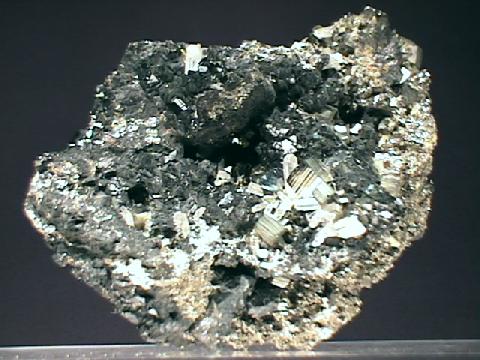
PYRITE specimen pyr-55
$ 45.00
$ 45.00
Dims: 4.8 x 3.6 x 2.7" (12.2 x 9.1 x 6.9 cm)
Wt: 2 lbs., 2.8 oz. (986 g)
Pachapaque Mine, Ancash Department, Peru
Several Pyrite cubes are partly intergrown with the Pyrite/sphalerite base of this cabinet specimen. Most of the cubes have been broken, but those that are intact are in good condition and measure nearly 0.4" (1 cm) in diameter, maximum. Their cubic form is slightly warped, and appears to show faint pyritohedral traits. All have the standard pale gold coloration and metallic luster, and are accompanied by several small quartz prisms and many heavily-intergrown sphalerites.

pyr-55 ($ 45.00)
Pachapaque Mine, Ancash Department, Peru

PYRITE specimen pyr-56
$ 50.00
$ 50.00
Dims: 9.2 x 7.4 x 0.5" (23.4 x 18.8 x 1.3 cm)
Wt: 1 lb., 3.1 oz. (542 g)
Sparta, Illinois, U.S.A.
A single Pyrite "sun" concretion rests on the black shale host of this piece. The sun is in excellent condition and has dimensions of 3.4 x 3.0 x 0.2" (8.6 x 7.6 x 0.5 cm). Its form is asymmetrical and shows the compact, radiating habit of the Pyrite. It has a golden coloration with a faint green caste and a dull metallic luster. The shale base has been coated with a clear lacquer to strengthen it and brighten its luster.

pyr-56 ($ 50.00)
Sparta, Illinois, U.S.A.

PYRITE specimen pyr-57
$ 36.00
$ 36.00
Dims: 6.2 x 6.0 x 0.2" (15.7 x 15.2 x 0.5 cm)
Wt: 1 lb., 0.9 oz. (480 g)
Sparta, Illinois, U.S.A.
This large Pyrite "sun" is in good condition, showing a small amount of damage and has an asymmetrical form. Its compact, radial habit is easy to see and its pale golden color is standard for its species. Its metallic luster varies in brightness, and the piece has only a very smal amount of the black shale host rock attached to it.

pyr-57 ($ 36.00)
Sparta, Illinois, U.S.A.

PYRITE specimen pyr-58
$ 70.00
$ 70.00
Dims: 2.3 x 1.7 x 1.4" (5.8 x 4.3 x 3.6 cm)
Wt: 3.37 oz. (95.6 g)
Nanisivik Mine, Baffin Island, Northwest Territories, Canada
A cluster of very warped Pyrite crystals makes up this hand specimen. These crystals are generally in good condition, as a few are noticeably damaged or broken, and reach visible dimensions of 0.8 x 0.4 x 0.4" (1.9 x 1.1 x 0.9 cm). Their form appears to be nearly tetrahexahedral, though it contains a few extra, tiny faces. The warping may have something to do with the fact that these crystals formed as marcasites, then pseudomorphed into Pyrite and were likely overgrown with more Pyrite. All have the pale golden color and metallic luster of Pyrite and are moderately to heavily intergrown with each other. The cluster coats a cluster of crystalline but badly broken sphalerites.

pyr-58 ($ 70.00)
Nanisivik Mine, Baffin Island, Northwest Territories, Canada
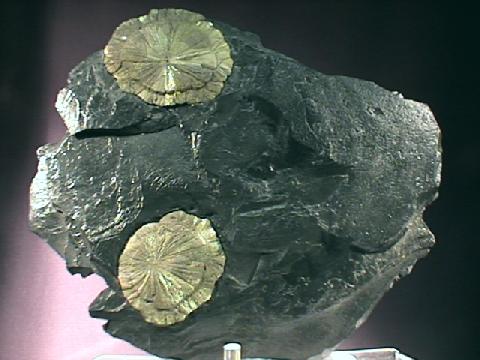
PYRITE specimen pyr-59
$ 80.00
$ 80.00
Dims: 11.0 x 9.2 x 2.0" (27.9 x 23.4 x 5.1 cm)
Wt: 6.2 lbs. (2.8 kg)
Sparta, Illinois, U.S.A.
This large piece consists of 2 Pyrite "suns" that are partly embedded in a black shale base. They have dimensions of 3.4 x 3.0 x 0.2 " (8.8 x 7.6 x 0.5 cm) and 2.9 x 2.5 x 0.2" (7.5 x 6.4 x 0.4 cm) and are both in excellent condition. They are not symmetrical but have good form nonetheless. Their golden color is moderately deep and shows a faint green caste, and their luster varies from bright to dull metallic. Their shale base is coated with a lacquer to strengthen it and brighten its luster.

pyr-59 ($ 80.00)
Sparta, Illinois, U.S.A.

PYRITE specimen pyr-60
$ 30.00
$ 30.00
Dims: 5.3 x 5.2 x 0.2" (13.5 x 13.2 x 0.5 cm)
Wt: 11.6 oz. (329 g)
Sparta, Illinois, U.S.A.
This large Pyrite sun is in good condition, showing some moderate damage on parts of its edge. It has a generally round but irregular shape and has a heavy crack running partway through it that was incurred during its formation. It has a deep, dull golden color with noticeable pink iridescence and a metallic luster, and shows the classic radial patterning of such concretions.

pyr-60 ($ 30.00)
Sparta, Illinois, U.S.A.

PYRITE specimen pyr-61
$ 50.00
$ 50.00
Dims: 12.7 x 10.1 x 1.5" (32.3 x 25.7 x 3.8 cm)
Wt: 6.2 lbs. (2.8 kg)
Sparta, Illinois, U.S.A.
A small Pyrite "sun" concretion lies in the middle of the large, flat shale base of this piece. It has visible dimensions of 3.3 x 2.9" (8.4 x 7.5 cm) and is in excellent condition, showing no visible damage. Its color is a pale gold and its luster is metallic. The black shale base on which it rests has been covered with a protective lacquer.

pyr-61 ($ 50.00)
Sparta, Illinois, U.S.A.

PYRITE specimen pyr-62
$ 25.00
$ 25.00
Dims: 4.8 x 4.7 x 0.2" (12.2 x 11.9 x 0.5 cm)
Wt: 6.65 oz. (188.7 g)
Sparta, Illinois, U.S.A.
This oddly-shaped Pyrite sun is in good condition- it shows moderate damage on one part of its edge, but most of this damage is not new. The piece has a very irregular shape but still shows patterns denoting a compact, radiating habit. Its dull golden color exhibits a faint, blue-green iridescence in some areas and its luster is a dull metallic.

pyr-62 ($ 25.00)
Sparta, Illinois, U.S.A.

PYRITE specimen pyr-63
$ 70.00
$ 70.00
Dims: 12.0 x 9.4 x 0.7" (30.5 x 23.9 x 1.8 cm)
Wt: 4 lbs., 2.2 oz. (1.878 kg)
Sparta, Illinois, U.S.A.
A small "Pyrite Sun" rests on the ample black shale base of this specimen. The sun has dimensions of 3.9 x 3.0" (9.9 x 7.6 cm) and is in excellent condition, showing no damage. It has a pale golden color and a metallic luster, and was likely broken out of the base and then re-set. The black shale base is cracked and likely coated with a thin, clear lacquer to stabilize it.

pyr-63 ($ 70.00)
Sparta, Illinois, U.S.A.

PYRITE specimen pyr-64
$ 49.00
$ 49.00
Dims: 11.5 x 6.7 x 0.8" (29.2 x 17.0 x 2.0 cm)
Wt: 2 lbs., 2.0 oz. (1.077 kg)
Sparta, Illinois, U.S.A.
This pyrite concretion rests near the edge of a large base of black shale, and is in good condition, showing a small amount of breakage where the sun overlapped the edge of the base rock. The sun itself has visible dimensions of 4.5 x 3.6" (11.4 x 9.1 cm). Its form is somewhat warped and it has a deep golden color and a moderately-bright-to-dull metallic luster. It was likely separated from the base and then re-attached. The base material itself is coated with a clear lacquer to stabilize it and give it a brighter luster.

pyr-64 ($ 49.00)
Sparta, Illinois, U.S.A.

PYRITE specimen pyr-65
$ 48.00
$ 48.00
Dims: 6.5 x 5.6 x 0.5" (16.5 x 14.2 x 1.3 cm)
Wt: 14.5 oz. (412 g)
Sparta, Illinois, U.S.A.
This rather interesting "Pyrite Sun" is in excellent condition and has a diameter of about 3.3" (8.4 cm). Its form is round and quite regular, with one exception- a "wedge" of material is missing, making it look a bit like the "Pac Man" from a video arcade game. It has a mostly golden coloration- large portions are have a blue-green hue, however- and its metallic luster is generally dull. It was likely separated from its host rock, which was lacquered to stabilize it, and then re-affixed.

pyr-65 ($ 48.00)
Sparta, Illinois, U.S.A.

PYRITE specimen pyr-66
$ 33.00
$ 33.00
Dims: 8.1 x 5.8 x 0.2" (20.6 x 14.7 x 0.5 cm)
Wt: 8.67 oz. (245.9 g)
Sparta, Illinois, U.S.A.
The "Pyrite Sun" concretion on this specimen is rather small, having dimensions of 2.4 x 2.3" (6.1 x 5.8 cm) but is in good condition, showing no visible damage. Its form is shaped slightly like a pear, and it has a pale golden color and a dull metallic luster. Its black shale base is somewhat odd in the fact that it is not lacquered.

pyr-66 ($ 33.00)
Sparta, Illinois, U.S.A.
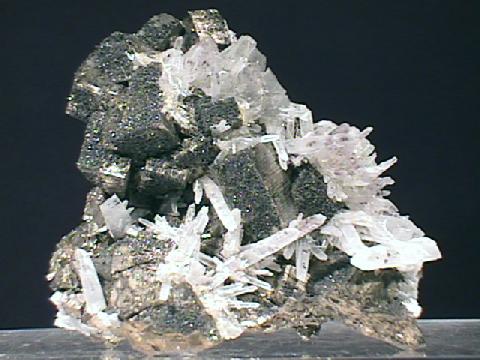
PYRITE specimen pyr-67
$ 25.00
$ 25.00
Dims: 2.9 x 2.7 x 1.6" (7.3 x 6.9 x 4.0 cm)
Wt: 6.59 oz. (187.0 g)
Huaron Mine, Ancash Department, Peru
Several intergrown Pyrite cubes make up most of the mass of this hand specimen. These cubes are generally in good condition, though those along the edges of the piece are usually damaged, and reach up to 0.7" (1.8 cm) in diameter. All have excellent cubic form, though most of their faces are covered with a thin, dark crust that I cannot define. All have the standard pale golden color and metallic luster, where visible. They are accompanied by several clusters of thin quartz crystals that are in fair condition and have a milky-white color. There is also a substantial amount of broken sphalerite attached to the bottom of the piece.

pyr-67 ($ 25.00)
Huaron Mine, Ancash Department, Peru

PYRITE specimen pyr-68
$ 28.00
$ 28.00
Dims: 7.2 x 3.9 x 0.8" (18.3 x 9.9 x 2.1 cm)
Wt: 6.59 oz. (187.0 g)
Sparta, Illinois, U.S.A.
One small Pyrite sun rests on the edge of the black shale base of this specimen. The sun has definitely been separated from and then re-attached to the base rock, but is in excellent condition, showing no visible damage. It is one of the most regular and symmetrical suns in our present stock, though it is not perfectly round. It shows the classic pale golden color and metallic luster of its species. The shale base is rough and has a dull luster- it is one of the few in our stock whose base is not coated with a protective layer.

pyr-68 ($ 28.00)
Sparta, Illinois, U.S.A.

PYRITE specimen pyr-69
$ 29.00
$ 29.00
Dims: 3.7 x 3.7 x 0.3" (8.4 x 8.4 x 0.7 cm)
Wt: 5.05 oz. (143.1 g)
Sparta, Illinois, U.S.A.
This single Pyrite "sun" is in excellent condition, showing no appreciable damage. Its flattened concretionary form is quite good, as it is generally more round and symmetrical than most. It has the pale golden color and dull metallic luster that is common for pieces from this locality. It is not attached to any host rock.

pyr-69 ($ 29.00)
Sparta, Illinois, U.S.A.

PYRITE specimen pyr-70
$ 25.00
$ 25.00
Dims: 3.4 x 1.8 x 1.5" (8.5 x 4.5 x 3.7 cm)
Wt: 7.5 oz. (214 g)
Pachapaque Mine, Ancash Department, Peru
Several dozen heavily-intergrown Pyrite crystals make up the bulk of this hand specimen. These crystals are generally in good condition and have visible diameters of up to 0.4" (1.0 cm). All have excellent pyritohedral form, with well-defined edges and clean faces, and show the standard pale-golden color and metallic luster of the species. The Pyrites are accompanied by many warped, intergrown and heavily-worn sphalerites that also do not appear to exceed 0.4" (1 cm) in diameter. They seem to be weathered, however, as their luster is quite dull.

pyr-70 ($ 25.00)
Pachapaque Mine, Ancash Department, Peru

PYRITE specimen pyr-71
$ 54.00
$ 54.00
Dims: 10.4 x 6.9 x 0.6" (26.4 x 17.5 x 1.5 cm)
Wt: 1 lb., 10.2 oz. (744 g)
Sparta, Illinois, U.S.A.
At least 2 intergrown Pyrite "sun" concretions rest on a black shale base. These suns generally do not exceed 2.4" (6 cm) in diameter, and since they are intergrown, I will consider them as a single unit. It is in very good condition, showing only one small area of visible damage, and has the standard pale golden coloration and metallic luster of its species. Its black shale base has been lacquered to strengthen it and to deepen its color and brighten its luster.

pyr-71 ($ 54.00)
Sparta, Illinois, U.S.A.

PYRITE specimen pyr-72
$ 54.00
$ 54.00
Dims: 11.9 x 7.6 x 1.1" (30.2 x 19.3 x 2.8 cm)
Wt: 2 lbs., 12.6 oz. (1.265 kg)
Sparta, Illinois, U.S.A.
A single Pyrite "sun" rests on a black shale base. This sun is in excellent condition and has a somewhat regular but asymmetrical form. Its color is pale golden and its luster is metallic. The shale base on which it rests is rough in texture and dull in luster and contained a second sun at one time that was broken out- a small portion is still present.

pyr-72 ($ 54.00)
Sparta, Illinois, U.S.A.

PYRITE specimen pyr-73
$ 28.00
$ 28.00
Dims: 4.7 x 4.1 x 1.0" (11.9 x 10.4 x 2.5 cm)
Wt: 1 lb., 0.7 oz. (474 g)
Sparta, Illinois, U.S.A.
This piece consists of a small Pyrite "sun" concretion that rests on a thick piece of black shale. The sun is in fair condition, showing obvious damage in one area and less noticeable damage in another, and has an oval shape. Its pale-golden color and metallic luster are standard for such concretions. Its thick base allows it to be set upright on one edge.

pyr-73 ($ 28.00)
Sparta, Illinois, U.S.A.

PYRITE specimen pyr-74
$ 60.00
$ 60.00
Dims: 10.5 x 7.9 x 0.9" (26.7 x 20.1 x 2.3 cm)
Wt: 2 lbs., 8.5 oz. (1.147 kg)
Sparta, Illinois, U.S.A.
This colorful Pyrite "sun" is in excellent condition and has dimensions of 3.9 x 3.2" (9.8 x 8.2 cm). It is in excellent condition and has a reasonably good, ovoid shape. Its luster is metallic and its color is a pale gold, but it has iridescence that shows red, green and dull blue hues. It partly overhangs on the edge of its lacquered black shale base.

pyr-74 ($ 60.00)
Sparta, Illinois, U.S.A.

PYRITE specimen pyr-75
$ 42.00
$ 42.00
Dims: 9.7 x 8.2 x 1.3" (24.6 x 20.8 x 3.3 cm)
Wt: 4 lbs., 0.2 oz. (1.821 g)
Sparta, Illinois, U.S.A.
This Pyrite "sun" is in excellent condition, showing no appreciable damage, and has dimensions of 3.1 x 2.4" (7.9 x 6.1 cm). Its shape is rather irregular and it has the pale-golden color and metallic luster of its species. The thick, black shale base upon which it rests has a few gouge marks in it and is dull in luster.

pyr-75 ($ 42.00)
Sparta, Illinois, U.S.A.
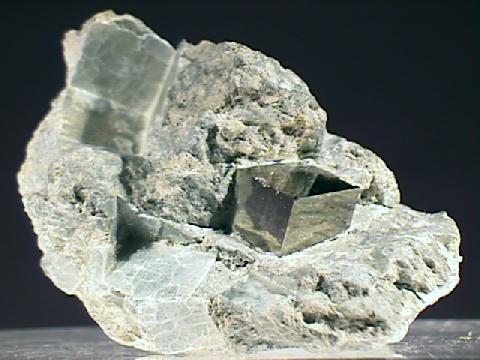
PYRITE specimen pyr-76
$ 25.00
$ 25.00
Dims: 2.8 x 2.5 x 1.8" (7.1 x 6.3 x 4.6 cm)
Wt: 5.97 oz. (169.5 g)
El Navajun, La Rioja, Spain
Three Pyrite cubes rest in the pale gray host rock of this hand specimen. The smallest cube, measuring about 0.1" (3 mm) in diameter, is badly damaged and incomplete, but the larger ones are in very good condition, showing light damage, and measure up to 0.5" (1.3 cm) along an edge. All have excellent form, with very well-defined edges and clean faces, and show the standard pale golden color and metallic luster of their species.

pyr-76 ($ 25.00)
El Navajun, La Rioja, Spain

PYRITE specimen pyr-77
$ 45.00
$ 45.00
Dims: 5.0 x 3.9 x 2.1" (12.7 x 9.9 x 5.3 cm)
Wt: 2 lbs, 11.5 oz. (1.232 kg)
Raura Mine, Ancash Department, Peru
A thick Pyrite crust covers the sparse galena base of this cabinet specimen. The Pyrite crust is made up of hundreds of heavily-intergrown crystals, almost all of which are in excellent condition. They generally do not exceed 0.4" (1.0 cm) in diameter and have excellent pyritohedral form where exposed. The crystals are clustered into nearly botryoidal formations that extend a short distance upward from the crust. All have a pale golden color and a metallic luster.

pyr-77 ($ 45.00)
Raura Mine, Ancash Department, Peru

PYRITE specimen pyr-78
$ 115.00
$ 115.00
Dims: 10.9 x 8.6 x 1.0" (27.7 x 21.8 x 2.5 cm)
Wt: 3 lbs., 4.8 oz. (1.497 g)
Sparta, Illinois, U.S.A.
This large display piece consists of a black shale base that holds 2 Pyrite "suns". These flat concretions are in excellent condition and reach up to 3.2 x 2.6" (8.0 x 6.6 cm). Both are somewhat irregular in shape and have the standard pale golden color and metallic luster, but also show iridescent red, green and orange colors. The shale base has been lacquered to strengthen it and make it appear darker.


pyr-78 ($115.00)
Sparta, Illinois, U.S.A.

PYRITE specimen pyr-79
$ 70.00
$ 70.00
Dims: 2.4 x 1.7 x 1.0" (6.2 x 4.3 x 2.4 cm)
Wt: 2.84 oz. (80.6 g)
Nanisivik Mine, Baffin Island, Northwest Territory, Canada
This odd hand specimen consists of a cluster of Pyrite crystals that pseudomorphed from marcasite. These crystals reach maximum dimensions of 0.8 x 0.6 x 0.3" (2.1 x 1.4 x 0.7 cm) and are generally in good condition, though a considerable amount of damage is visible in areas. Their isometric-based form is rather warped, and appears to take on a variety of different shapes, including cubo-octahedral, dodecahedral, and pyritohedral- there may even be a gyroid or two. All have the standard pale golden color and a slightly dull metallic luster.


pyr-79 ($ 70.00)
Nanisivik Mine, Baffin Island, Northwest Territory, Canada

PYRITE specimen pyr-81
$ 60.00
$ 60.00
Dims: 2.4 x 1.5 x 1.4" (6.1 x 3.8 x 3.6 cm)
Wt: 4.69 oz. (133.1 g)
Nanisivik Mine, Baffin Island, Northwest Territory, Canada
This specimen consists of part of a crust of heavily-intergrown and very warped Pyrite crystals. These crystals reach dimensions of 0.5 x 0.4 x 0.3" (1.3 x 1.0 x 0.8 cm) and are in moderately good condition, showing considerable damage in some areas. They are pseudomorphs after marcasite, and their severely warped forms reflect it- I cannot figure out which variation of the cubic and/or orthorhombic forms they have adopted! Otherwise, they have the standard pale golden color and metallic luster of the specie. There is no host rock present.

pyr-81 ($ 60.00)
Nanisivik Mine, Baffin Island, Northwest Territory, Canada

PYRITE specimen pyr-82
$ 90.00
$ 90.00
Dims: 6.6 x 4.3 x 3.8" (16.8 x 10.9 x 9.6 cm)
Wt: 2 lbs., 13.6 oz. (1.292 kg)
Naica, Chihuahua, Mexico
This large cabinet specimen consists of a calcite base on which rest many clusters of Pyrite crystals that probably pseudomorphed from marcasite. Some of these cubes, if complete, would measure 0.7" (1.8 cm) along an edge, but they are all heavily intergrown in clusters. There is a small amount of damage and breakage present, but most are in very good condition. Their form could be cubic, but the curved edges of these "cubes" are very common for the orthorhombic form of marcasite. Many of the clusters have a strong red tint to them, but there are several that show the standard pale golden color.


pyr-82 ($ 90.00)
Naica, Chihuahua, Mexico

PYRITE specimen pyr-83
$ 50.00
$ 50.00
Dims: 6.6 x 3.6 x 1.8" (16.8 x 9.2 x 4.5 cm)
Wt: 1 lb., 10.3 oz. (745 g)
Amax Mine, Reynolds County, Missouri, U.S.A.
Several Pyrite "bars" are embedded among scores of small, warped and heavily intergrown Pyrite cubes that rest on the thin limestone base of this cabinet specimen. These bars measure up to 4.9" (12.4 cm) in length and are in fair condition, as the largest and most exposed is broken and incomplete. Their form is reasonably good, but only a few of the surrounding cubes are definable as crystals. All have the standard pale golden color and metallic luster. I believe that all are pseudomorphs after marcasite, because their general form and appearance exactly match that of marcasite from this locality.
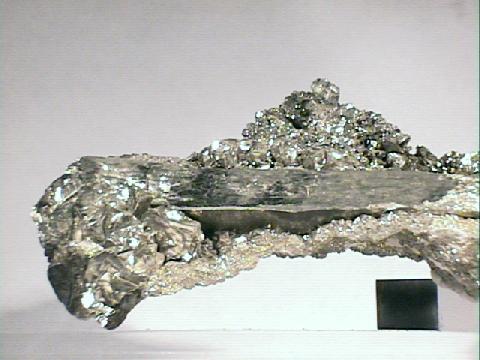

pyr-83 ($ 50.00)
Amax Mine, Reynolds County, Missouri, U.S.A.

PYRITE specimen pyr-84
$ 26.00
$ 26.00
Dims: 4.4 x 2.8 x 2.3" (11.0 x 7.2 x 5.8 cm)
Wt: 1 lb., 5.1 oz. (597 g)
Naica, Chihuahua, Mexico
This small cabinet specimen consists of several intergrown clusters of heavily-intergrown Pyrite cubes. They are in moderately good condition (one edge is badly damaged) and are so intergrown that defining a single crystal is almost impossible. Their cubic form is suspiciously rounded, and makes me almost sure that it pseudomorphed from marcasite. All have the classic pale golden color and metallic luster. A few small "dogtooth" calcites rest next to the Pyrite- they are coated with what might be actual marcasite, some of which has began to decayto produce a rusty product. The base rock appears to be made up of calcite and limestone.

pyr-84 ($ 26.00)
Naica, Chihuahua, Mexico

PYRITE specimen pyr-85
$ 70.00
$ 70.00
Dims: 2.3 x 1.2 x 1.1" (5.8 x 3.3 x 2.7 cm)
Wt: 4.17 oz. (118.4 g)
Nanisivik Mine, Baffin Island, Northwest Territory, Canada
A cluster of flattened, heavily-intergrown Pyrites makes up this hand specimen. Two of the crystals are heavily damaged, but the rest are in excellent condition. Their warped form is very difficult to define- there could be warped trapezohedrons, pyritohedrons, or even gyroids present- it is difficult to tell what is what. All have the standard pale golden color and metallic luster of Pyrite, and there is no base or host rock present. These pieces originally pseudomorphed from Marcasite, and I believe that after the process was finished, they continued to grow as Pyrite, hence the warped forms.


pyr-85 ($ 70.00)
Nanisivik Mine, Baffin Island, Northwest Territory, Canada

PYRITE specimen pyr-86
$ 70.00
$ 70.00
Dims: 1.9 x 1.6 x 1.0" (4.9 x 4.1 x 2.5 cm)
Wt: 2.12 oz. (60.2 g)
Nanisivik Mine, Baffin Island, Northwest Territory, Canada
This small hand specimen consists of a cluster of highly warped and heavily intergrown Pyrite crystals. These crystals pseudomorphed from marcasite and then likely continued their growth, resulting in their odd forms- one tiny crystal appears to be dodecahedral, but the rest are so warped and intergrown that I cannot make out any other definite shapes. There is considerable damage on portions of the piece, but most of the crystals are intact and in good condition. All have the classic pale golden color and metallic luster of Pyrite, and appear to be accompanied by many small, broken sphalerites.


pyr-86 ($ 70.00)
Nanisivik Mine, Baffin Island, Northwest Territory, Canada

PYRITE specimen pyr-87
$ 27.00
$ 27.00
Dims: 1.9 x 0.8 x 0.7" (4.7 x 2.1 x 1.8 cm)
Wt: 1.3 oz. (38 g)
Huanzala Mine, Huallanca District, Dos de Mayo Province, Huanuco Department, Peru
This hand specimen consists of a section of Pyrite stalactite. The stalactite has a surface consisting of many intergrown, partial crystals, all of which are in excellent condition and reach up to 0.4" (1.1 cm) in diameter. All of these crystals show excellent isometric pyritohedral form and the classic pale golden color and metallic luster of their specie. There is no host rock present.

pyr-87 ($ 27.00)
Huanzala Mine, Huallanca District, Dos de Mayo Province, Huanuco Department, Peru

PYRITE specimen pyr-88
$ 135.00
$ 135.00
Dims: 9.9 x 4.3 x 3.4" (25.2 x 10.9 x 8.6 cm)
Wt: lbs. ( kg)
Nanisivik Mine, Baffin Island, Northwest Territory, Canada
This large display specimen consists entirely of a thick Pyrite crust off of which protrude scores of warped crystals. These crystals range in size from less than 0.1" (3 mm) square to 1.4 x 0.7 x 0.4" (3.6 x 1.8 x 1.1 cm) and are generally in good condition, though several are damaged, and a few heavily so. All have a warped form that likely is caused by the fact that they were pseudomorphed from marcasite, partially overgrowing their old orthorhombic tendencies. All have a rather dull, pale golden color and an equally dull metallic luster, though damaged areas are much brighter. There is no other material present. Though I do not know its weight upon writing this description, I know that the piece weighs at least 10 lbs (approx. 4.5 kg)!


pyr-88 ($135.00)
Nanisivik Mine, Baffin Island, Northwest Territory, Canada

PYRITE specimen pyr-89
$ 135.00
$ 135.00
Dims: 7.0 x 5.5 x 4.8" (17.8 x 14.0 x 12.2 cm)
Wt: lbs. ( Kg)
Nanisivik Mine, Baffin Island, Northwest Territories, Canada
(2 pcs.) This specimen consists of a set of cut and partly polished Pyrite bookends. One of the bookends is noticeably larger than the other and weighs considerably more. It also shows much more damage, however, and much less crystal form. The crystals in these pieces appear to be aggregated into large, thick tablets that extend from more massive material- this likely has something to do with the fact that the Pyrite pseudomorphed from marcasite. The natural crystalline material has a dull, dark golden color and a dull metallic luster, but the damaged and polished areas show the brighter, pale-golden color and metallic luster that is expected. Each piece has two cut faces- one is polished to a high gloss, and the other is coated with black felt.
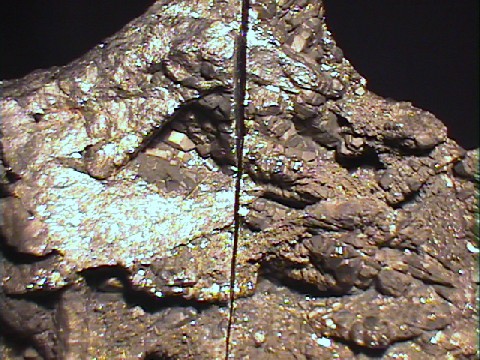

pyr-89 ($135.00)
Nanisivik Mine, Baffin Island, Northwest Territories, Canada

PYRITE specimen pyr-90
$ 150.00
$ 150.00
Dims: 6.0 x 5.8 x 2.7 (15.1 x 14.7 x 6.9 cm)
Wt: lbs. ( Kg)
Nanisivik Mine, Baffin Island, Northwest Territory, Canada
These two partly-cut Pyrite chunks could easily be used as bookends- actually, they were likely cut for that purpose, but one was broken and repaired. Their uncut surfaces are lined with hundreds of intergrown Pyrite crystals whose warped forms are caused by its pseudomorphism after marcasite. Their golden-yellow color and metallic luster are a bit duller than that of most Pyrite that I have seen, and some of the crystals on the repaired piece are damaged. One surface on each piece is ground smooth and polished to a high luster, and the other cut surface on each is lined with black felt.


pyr-90 ($150.00)
Nanisivik Mine, Baffin Island, Northwest Territory, Canada

PYRITE specimen pyr-92
$ 35.00
$ 35.00
Dims:3.4x3.1x2.0" (8.6x7.9x5.1 cm)
Wt: 10.4oz. (295g)
Navajun, La Rioja, Spain
Three blocky crystals of pyrite are embedded in the limestone matrix of this specimen. Two of the crystals are small, while the third reaches 1.0" (2.5cm) in length. These Navajun pyrites make for a striking display. There are only two tiny chips out of the large crystal (almost unnoticeable).

pyr-92 ($ 35.00)
Navajun, La Rioja, Spain

PYRITE specimen pyr-93
$ 32.00
$ 32.00
Dims:3.0x2.2x1.4" (7.6x5.6x3.6 cm)
Wt: 8.8oz. (250g)
Navajun, La Rioja, Spain
There are at least 5 pyrite crystals embedded in the matrix of this specimen, including one large crystal measuring 0.8" (2.0cm) on edge. Only the smallest pyrite crystal (less than 0.1", 0.3cm) is damaged, and this crystal is on the bottom of the specimen. This is an excellent display piece.

pyr-93 ($ 32.00)
Navajun, La Rioja, Spain
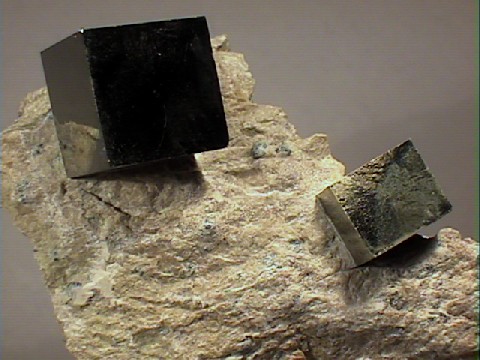
PYRITE specimen pyr-94
$ 45.00
$ 45.00
Dims:3.7x3.1x2.1" (9.4x7.9x5.3 cm)
Wt: 9.0oz. (256g)
Navajun, La Rioja, Spain
There are only two pyrite crystals visible on this specimen, but both are large and well-formed. The larger of these two crystals measures 0.7" (1.8cm) on edge. There are a couple of very tiny dings on these crystals (not noticeable unless one really looks for them).

pyr-94 ($ 45.00)
Navajun, La Rioja, Spain

PYRITE specimen pyr-95
$ 45.00
$ 45.00
Dims:1.9x1.4x1.4" (4.8x3.6x3.6 cm)
Wt: 4.1oz. (116g)
Pachapaqui, Peru
This specimen is a mass of crystalline pyrite that has been cut and polished into the shape of an egg. Many cavities within this piece reveal crystals of pyrite to 0.1" (0.3cm) in size. Given the nature of this mineral, it must have taken a great deal of patience and care to produce this work of art. It is undamaged.

pyr-95 ($ 45.00)
Pachapaqui, Peru

PYRITE specimen pyr-96
$ 43.00
$ 43.00
Dims:3.6x2.9x2.2" (9.1x7.4x5.6 cm)
Wt: 9.3oz. (265g)
Navajun, La Rioja, Spain
There are at least 9 pyrite crystals embedded in the matrix of this specimen, including one very large crystal (0.9", 2.3cm on edge). One of the smaller pyrites is missing a corner-otherwise, this specimen is undamaged. It sits naturally in a position to display the large crystal.

pyr-96 ($ 43.00)
Navajun, La Rioja, Spain

PYRITE specimen pyr-97
$ 41.00
$ 41.00
Dims:3.6x2.6x1.7" (9.1x6.6x4.3 cm)
Wt: 9.3oz. (265g)
Navajun, La Rioja, Spain
There are at least six excellent pyrite crystals on this specimen. The largest measures 0.7" (1.8cm) on edge. There is the faintest of nicks in the edge of the large pyrite crystal. These Navajun pieces make some of the most beautiful display pieces seen.

pyr-97 ($ 41.00)
Navajun, La Rioja, Spain

PYRITE specimen pyr-98
$ 46.00
$ 46.00
Dims:4.0x2.2x1.8" (10.1x5.6x4.6 cm)
Wt: 8.4oz. (238g)
Navajun, La Rioja, Spain
I count 5 pyrite crystals embedded in the matrix of this specimen, 2 large, and 3 small. One of the small crystals is actually a penetration twin on the largest crystal (0.8", 2.0cm on edge). There is no damage to these crystals. This is a striking display piece.

pyr-98 ($ 46.00)
Navajun, La Rioja, Spain

PYRITE specimen pyr-99
$ 37.00
$ 37.00
Dims:3.2x2.7x2.1" (8.1x6.9x5.3 cm)
Wt: 10.4oz. (294g)
Navajun, La Rioja, Spain
I count four pyrite crystals embedded in the matrix of this specimen, including one large crystal that is not quite a perfect cube. It developed more quickly in two directions than in the third, so that it measures 1.0x1.0x0.6" (2.5x2.5x1.5cm). This specimen is an excellent display piece. There is no damage to this specimen.

pyr-99 ($ 37.00)
Navajun, La Rioja, Spain

PYRITE specimen pyr-100
$ 43.00
$ 43.00
Dims:2.9x2.9x1.9" (7.4x7.4x4.8 cm)
Wt: 8.4oz. (237g)
Navajun, La Rioja, Spain
Two large (to 0.7", 1.8cm on edge) pyrite crystals Protrude from the matrix of this specimen. I count at least six other pyrites showing in the matrix, all much smaller than the two large crystals. This specimen makes a great display piece-it shows no damage at all.

pyr-100 ($ 43.00)
Navajun, La Rioja, Spain

PYRITE specimen pyr-102
$ 38.00
$ 38.00
Dims:3.5x2.6x2.0" (8.9x6.6x5.1 cm)
Wt: 9.0oz. (256g)
Navajun, La Rioja, Spain
I count 8 crystals of pyrite embedded in the limestone matrix of this specimen, although the two larger crystals on top immediately draw the eye. The largest crystal measures just over 0.7" (1.8cm) on edge. These crystals are excellent-no damage at all.

pyr-102 ($ 38.00)
Navajun, La Rioja, Spain

PYRITE specimen pyr-101
$ 97.00
$ 97.00
Dims:2.0x2.0x1.9" (5.1x5.1x4.8 cm)
Wt: 9.3oz. (264g)
Peru
This specimen consists of a sphere, cut and polished from a mass of Peruvian pyrite. Cavities in the sphere hold crystals of pyrite to 0.2" (0.5cm). With such a brittle mineral, it is not difficult to appreciate the workmanship that went into this specimen. This piece is undamaged.


pyr-101 ($ 97.00)
Peru

PYRITE specimen pyr-103
$ 50.00
$ 50.00
Dims: 1.7 x 1.6 x 1.4" (4.4 x 4.0 x 3.5 cm)
Wt: 3.0 oz. (84.9g)
Arroya de la Conadilla, Ambasaguas, La Rioja, Spain
Interpenetrating twins or simply a cluster of pyrite cubes dominated by a single crystal, I can't say for sure. This aesthetic specimen has all of the crystal faces curved in a concave shape, and they are also stongly striated. This specimen is undamaged.


pyr-103 ($ 50.00)
Arroya de la Conadilla, Ambasaguas, La Rioja, Spain

PYRITE specimen pyr-104
$ 25.00
$ 25.00
Dims: 4.2x2.7x0.9" (10.6x6.9x2.2cm)
Wt: 9.08 oz. (257g)
Grand Prairie, Dallas County, Texas, USA
This is a concretion or nodule that appears to consist mostly of impure pyrite, and mostly coated with a thin layer of white and/or green crystals of something I cannot identify. The crystals look alike (save for the color) - they are fine soft crystals, often curved, arranged in random tufts. The nodule also has several nice pyrite growths, some botryoidal, some intergrown masses of rounded cubes.

pyr-104 ($ 25.00)
Grand Prairie, Dallas County, Texas, USA

PYRITE specimen pyr-105
$ 95.00
$ 95.00
Dims: 2.95x2.80x2.60" (7.5x7.1x6.6cm)
Wt: 14.46 oz (409.2g)
Volga River, Russia
As the mudball that formed this concretion dried and shrank, several internal cracks developed. At some point, these cracks became coated with tiny pyrite crystals, and these developed an irridescent coating. The resulting colors include brassy hues of gold, blue, purple, and red. Under a loupe, the pyrite crystals resolve into tiny intergrown cubes. This is a colorful pyrite specimen.
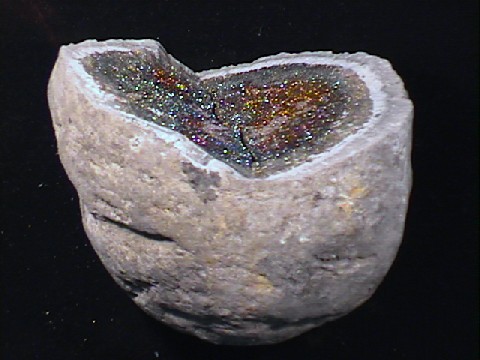

pyr-105 ($ 95.00)
Volga River, Russia

PYRITE specimen pyr-108
$ 50.00
$ 50.00
Dims: 5.00x2.09x1.95" (12.71x5.30x4.95cm)
Wt: 16.2oz (458g)
Duff & Sons Quarry, Huntsville, Ohio, USA
This pyrite specimen consists of a siltstone matrix with layers of dark material which look like many fossils I have seen. Some of the dark layers outline a cavity in which three minerals are found, including calcite, aragonite (I think), and the pyrite. Of course, the pyrite is the most aesthetic part, in the form of relatively small pyritohedrons with a brassy color and with an irridescent tarnish.


pyr-108 ($ 50.00)
Duff & Sons Quarry, Huntsville, Ohio, USA
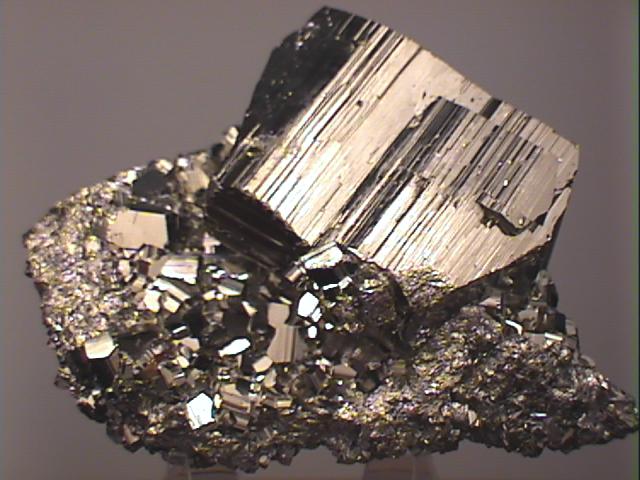
PYRITE specimen pyr-109
$ 60.00
$ 60.00
Dims: 4.03x2.91x2.50" (10.23x7.40x6.34cm)
Wt: 20.64oz (585g)
Uruchacua Mine, Ancash, Peru
This is an excellent hand specimen of pyrite. It is dominated by a single crystal more than 6cm in length and with a rather complex shape (largely square) highlighted by striations on each face at right angles to those on the adjacent faces. This large crystal rests on a base of small loosely intergrown pyrite crystals with a similar habit. Filling many of the cavities between the pyrite crystals are white opaque crystals of something, likely calcite or a similar mineral that has been disolved away to expose the pyrite.


pyr-109 ($ 60.00)
Uruchacua Mine, Ancash, Peru

PYRITE specimen pyr-106
$ 30.00
$ 30.00
Dims: 2.40x1.64x1.25" (6.09x4.17x3.18cm)
Wt: 3.71oz (105.2g)
Volga River, Russia
This is a concretion that developed internal cracks as it dried, which developed a coating of metal sulfide crystals. The miner believes that they are simply pyrite, but the gradiations of shapes and colors tell me that there are multiple metal sulfides here, including at the least pyrite and chalcopyrite, but likely also bornite and possibly marcasite. There are areas that are the typical brassy colors of pyrite and marcasite, with two distinctly different forms. There are other areas which have yellow and green irridescent tarnishes like chalcopyrite, and other areas with blue and purple irridescent tarnishes like bornite. In addition, there are areas where the metal sulfide is distinctly red in hue, and I am not sure what this might be.


pyr-106 ($ 30.00)
Volga River, Russia

PYRITE specimen pyr-107
$ 35.00
$ 35.00
Dims: 2.76x2.34x1.42" (7.00x5.94x3.62cm)
Wt: 4.75oz (134.6g)
Volga River, Russia
This is a lovely little concretion showing a coating of pyrite crystals. Most of the crystals are tiny and have a cubic appearance, and some of this has the brassy color of pyrite. Surrounding this is an area that looks more like marcasite, with curved crystal faces. Actually, most of the interior has an irridescent appearance, with some areas the colors of chalcopyrite, some the colors of bornite, and some actually looks very much like cuprite.


pyr-107 ($ 35.00)
Volga River, Russia